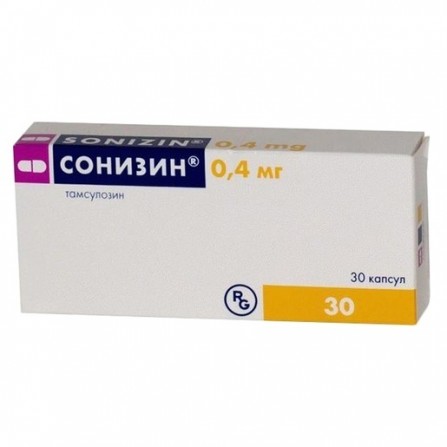Sonizin modified release capsule 0.4mg N30
Condition: New product
1000 Items
Rating:
Be the first to write a review!

More info
Active ingredients
Tamsulosin
Composition
1 caps tamsulosin hydrochloride 400 mcg. Excipients: Calcium Stearate - 0.
Pharmacological effect
Alpha1-blocker. Tamsulosin selectively and competitively blocks postsynaptic α1A-adrenergic receptors in smooth muscle of the prostate gland, bladder neck and prostatic urethra, as well as α1D-adrenoreceptors, mainly in the body of the bladder. This leads to a decrease in the tone of the smooth muscles of the prostate gland, the bladder neck and the prostatic part of the urethra and the improvement of the function of the detrusor. Due to this, the symptoms of obstruction and irritation associated with benign prostatic hyperplasia are reduced. As a rule, the therapeutic effect develops 2 weeks after the start of the drug, although in a number of patients a decrease in the severity of symptoms is observed after taking the first dose. The ability of tamsulosin to affect α1A-adrenergic receptors is 20 times greater than its ability to interact with α1B-adrenergic receptors, which are located in vascular smooth muscle. Due to such high selectivity, the drug does not cause any clinically significant reduction in blood pressure in patients with arterial hypertension, and in patients with normal baseline blood pressure.
Pharmacokinetics
Absorption: After oral administration, tamsulosin is rapidly and almost completely absorbed from the gastrointestinal tract. Bioavailability is about 100%. After a single dose of the drug is taken orally at a dose of 400 μg Cmax of tamsulosin in plasma, it is reached in 6 hours. Distribution: In equilibrium (after 5 days of exchange dose), the Cmax value of tamsulosin in plasma is 60-70% higher than Cmax after a single dose of the drug. Plasma protein binding - 99%. Tamsulosin has a negligible Vd (approximately 0.2 L / kg). Metabolism: Tamsulosin does not undergo the “first pass” effect and slowly biotransform itself in the liver to form pharmacologically active metabolites that retain a high selectivity for α1A-adrenergic receptors. Most of the active substance is present in the blood unchanged. Excretion: Tamsulosin is excreted by the kidneys, 9% of the dose is excreted unchanged.T1 / 2 of tamsulosin in a single dose of -10 h, after repeated administration of 13 h, the final T1 / 2 - 22 h.
Indications
- treatment of dysuria due to benign prostatic hyperplasia.
Contraindications
- hypersensitivity to the drug. The drug should be used with caution in case of chronic renal failure (with CC less than 10 ml / min), arterial hypotension (including orthostatic), severe liver failure.
Dosage and administration
Assign inside, after eating, 400 mcg (1 caps.) / Day, at the same time of day, drinking plenty of water. The capsule should not be torn apart or chewed, because this disrupts the prolonged release of the active substance.
Side effects
From the side of the central nervous system: rarely - headache, dizziness, asthenia, sleep disorders (drowsiness or insomnia). On the part of the reproductive system: rarely - retrograde ejaculation, decreased libido. Since the cardiovascular system: in rare cases - orthostatic hypotension, tachycardia, palpitations. On the part of the digestive system: in some cases - nausea, vomiting, constipation or diarrhea. Allergic reactions: in some cases - skin rash, itching, angioedema. Other: rarely - back pain, rhinitis; in rare cases - pain in the chest.
Interaction with other drugs
Cimetidine increases the concentration of tamsulosin in plasma, reduces furosemide (does not have significant clinical significance, dose change is not required). Diclofenac and indirect anticoagulants enhance the elimination of tamsulosin. Diazepam, propranolol, trichloromethiazide, chlormadinone, amitriptyline, diclofenac, glibenclamide, simvastatin and warfarin do not alter the free fraction of tamsulosin in human plasma in vitro. In turn, tamsulosin does not change the free fractions of diazepam, propranolol, trichloromethiazide and chlormadinone. In in vitro studies, no interaction at the level of hepatic metabolism with amitriptyline, salbutamol, glibenclamide, and finasteride was detected. Other alpha1-blockers, acetylcholinesterase inhibitors, alprostadil, anesthetics, diuretics, levodopa, antidepressants, beta-blockers, slow calcium channel blockers, nitrates and ethanol can increase the intensity of the hypotensive effect of tamsulosin.









